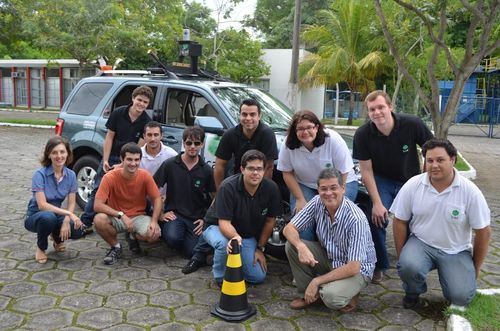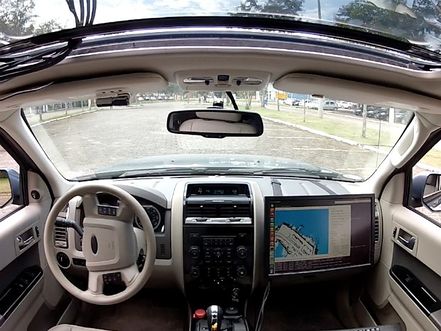Mudanças entre as edições de "DARPA"
| Linha 20: | Linha 20: | ||
== Our team == | == Our team == | ||
| − | The [[Equipe|Br Robotics Team]] is very proud to become one of the 26 teams qualified for VRC in the world. It is lead by [http://www.lcad.inf.ufes.br/team/index.php/Dr._Alberto_Ferreira_De_Souza Dr. Alberto Ferreira De Souza] from the High Performance Computing Laboratory [http://www.lcad.inf.ufes.br (LCAD)] of the Federal University of Espirito Santo [http://www.ufes.br (UFES)], located in the [http://en.wikipedia.org/wiki/Vit%C3%B3ria,_Esp%C3%ADrito_Santo city of Vitoria], Brazil. The team congregates several professors and students working on artificial vision, face recognition, autonomous vehicles and humanoid robot researches. ([[Equipe|See the team members list]]) | + | The [[Equipe|'''Br Robotics Team''']] is very proud to become one of the 26 teams qualified for VRC in the world. It is lead by [http://www.lcad.inf.ufes.br/team/index.php/Dr._Alberto_Ferreira_De_Souza Dr. Alberto Ferreira De Souza] from the High Performance Computing Laboratory [http://www.lcad.inf.ufes.br (LCAD)] of the Federal University of Espirito Santo [http://www.ufes.br (UFES)], located in the [http://en.wikipedia.org/wiki/Vit%C3%B3ria,_Esp%C3%ADrito_Santo city of Vitoria], Brazil. The team congregates several professors and students working on artificial vision, face recognition, autonomous vehicles and humanoid robot researches. ([[Equipe|See the team members list]]) |
{| border=0 width="10%" | {| border=0 width="10%" | ||
Edição das 15h53min de 7 de junho de 2013
What is DARPA?
The Defense Advanced Research Projects Agency (DARPA) is the U.S. Department of Defense (DoD) 's primary innovation engine. The Agency undertakes projects and scientific investigations aiming to create innovative technologies that address current practical problems. One of the focus areas of DARPA's Tactical Technology Office (TTO) is the development of unmanned systems to improve navigation in dynamic conditions, extend range and endurance, and increase adaptive autonomous operations. The DARPA Robotics Challenge (DRC) is all about that.
What is the DARPA Robotics Challenge?
Some natural or man-made disasters, due to grave risks to the health and wellbeing of rescue and aid workers, prove too great for timely and effective human response. The DARPA Robotics Challenge (DRC) intends to extend humanitarian aid to victims of disasters by promoting innovation in robotic technology for disaster-response operations.
The primary technical goal of the DRC is to develop ground robots capable of executing complex tasks in dangerous, degraded, human-engineered environments. Competitors in the DRC are expected to focus on robots that can use standard tools and equipment commonly available in human environments, ranging from hand tools to vehicles, with an emphasis on adaptability to tools with diverse specifications.
The DRC kicked off on October 24, 2012, and has three planned competitions, one virtual followed by two live. The first competition, the Virtual Robotics Challenge (VRC) is scheduled for June 17-28, 2013. The live robotics events are planned for December 2013 and December 2014.
The VRC competition will comprise three tasks in a robot simulator:
- Walk a short distance, climb into a utility vehicle, drive along a roadway, climb out of the utility vehicle, and walk to the finish area.
- Walk across progressively more difficult terrain. In the later one, perception and footstep planning will be expected.
- Connect a hose to a spigot and open the spigot by way of turning a valve.
(See the DARPA Robotics Challenge details)
Our team
The Br Robotics Team is very proud to become one of the 26 teams qualified for VRC in the world. It is lead by Dr. Alberto Ferreira De Souza from the High Performance Computing Laboratory (LCAD) of the Federal University of Espirito Santo (UFES), located in the city of Vitoria, Brazil. The team congregates several professors and students working on artificial vision, face recognition, autonomous vehicles and humanoid robot researches. (See the team members list)
| LCAD team and IARA autonomous vehicle | IARA autonomous ride through UFES campus |

